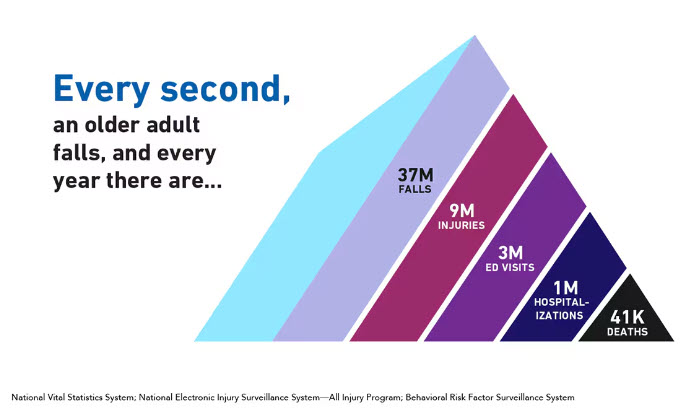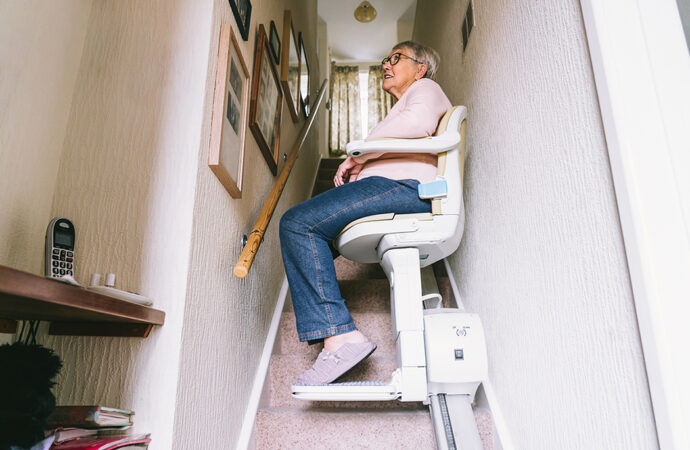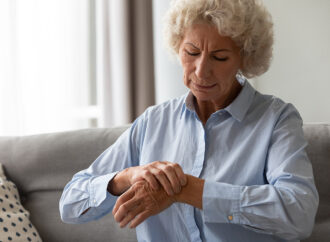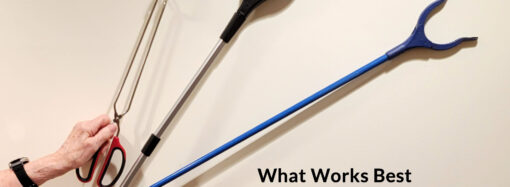If you’re like most people 55 and over, you’d like to be able to stay in your own home and community as you age. To achieve that goal as you age, you may need home modifications to improve your safety, independence, and comfort. Here’s a look at some of the problems people face as they age at home and how to cope with them for yourself or for family members.
Fall Prevention
Fall prevention is one of the most important reasons for making home modifications for aging. According to the Center for Disease Control (CDC), older adults in the U.S. suffer 37 million falls a year. Nearly one million of those falls resulting in hospitalization, most often from a head injury or hip fracture. Forty percent of falls result in death.

Mobility Issues
As people age, mobility issues can make moving in and around one’s home difficult. Climbing stairs, whether it’s to get into the house or to move between floors in the house, is a common challenge and safety concern for older people as well as others who have to use assistive devices to get around. Here are some home modifications for aging at home to improve safety and make life easier for people with mobility, balance and other concerns.
Chair Lifts
A common solution for navigating household stairs is a chair lift. Several families I know have have these installed because climbing stairs became too difficult for one or more household members. Chair lifts are helpful because they eliminate the physical strain of climbing stairs and mitigate the risk of injury due to falls on the stairway.
Chair lifts do what their name implies. They are chairs that carry you up the stairs. They operate along a rail that’s installed on one side of the stairway. The person who needs to travel up or down gets in the chair, fastens the seatbelt, and pushes a button. Then the chair slowly and safely carries them up or down the stairs.
When only one person in a home needs a chair lift, the partner often discovers an “off-label” advantage to having a chair lift. They use it to send heavy laundry baskets or other bulky items up or downstairs.
Chair lifts come tailored to fit various staircase designs – straight flights, curved paths, or even outdoor steps.
When not in use, the chair part of the chair lift folds up so that it’s not in the way of those who don’t need it. Depending on the model and the configuration of the stairway, some chair lifts move around a corner to the opposite side of the stairway wall when not in use.
Pricing for installing these devices can vary significantly depending on factors such as the chosen model and the complexity level of your unique stair layout, but generally expect costs ranging anywhere between $2,000-$10,000, including professional installation fees.
In-Home Elevators
An in-home elevator is a safe and convenient way to move between floors in your home if you have to use a wheelchair all the time or have other significant mobility issues. But they are more costly, and you need to have the space to install them.
Available in-home elevator models cover a wide range of features and benefits, catering to diverse needs and preferences Installation expenses will fluctuate greatly based on the selected model type, but they typically fall somewhere around the $20k-40K or more.
Ramps
Getting in and out of your home safely can be a challenge (or impossible) when you have to use a wheelchair or have decreased strength and balance, or other mobility issues. The same is true, if there’s a step or two up or down into a main living area.
Adding ramps can solve the problem. In fact, you’ve probably noticed homes that have had ramps added up that lead up to the home’s front door. But if there are bumps or small changes in floor height an indoor ramp might be useful as well.
Ramp installations tend to be less expensive than chair lifts and in-home elevators. But they still yield substantial mobility and accessibility improvements. They can make it easier for older adults to leave their home and mitigate social isolation and loneliness. According to estimates provided by industry experts, ramp construction usually ranges anywhere from approximately $1k-$5K or higher.
Exterior Railings
If adding a ramp isn’t essential and the cost or the way a ramp looks is an issue, another option is to add a railing to steps that have none. Adding an exterior railing makes it safer for anyone to climb the stairs, especially when rain or snow makes them slippery.
But for people who are a little unsteady on their feet, having a railing to use for support makes climbing stairs easier. Having something to hang onto also helps relieve worry about falling since there’s something to hang onto.
Similarly, a hand railing can be added in places in the home where the floor level changes.
The cost of railings varies depending on the type you choose, the location, and the length needed.
Home Improvement Safety Modifications
The process of aging in place demands a proactive approach to safety. A major worry for elderly people is the danger of slipping and falling, which, as the chart towards the top of this page shows, can cause serious injury or even death. Here are some types of home modifications you may want to consider.
If you decide to make major home modifications, be sure you get quotes from multiple contractors and research each of them. Check that they are licensed and insured in your location, and look for customer reviews. You want to be sure you are dealing with a reputable contractor and that they will guarantee their work.
Related content: Disaster-recovery scams
Bathroom Modifications
Given its inherently slippery surfaces and hard fixtures, the bathroom can present significant hazards for older adults – and for that matter, younger people, as well.
Grab Bars
One practical solution is to install grab bars in various locations for safety and support. Grab bars in the bath and shower stall facilitate bathing and reduce the risk of falls during bathing. You can get safety bars that attach to the wall or clip on over the tub. If positioned correctly they can be used for support to get in and out of the tub or shower stall, as well as to steady oneself if needed while bathing.
Temporary handholds and tub rails that you attach to the wall with suction cups can be installed quickly, do not require permanent renovations, and can be easily removed or relocated to a different bathroom.
A study published by the National Library of Medicine found that 15% of suction cup devices did not meet loading requirements. Move over, more than half of the people in a test group installed hand grabs and tub rails incorrectly.
If removable devices aren’t installed properly or on the appropriate surface, they can be a danger. For example, a suction cup grab bar we had in one of our showers would fall off the wall sometimes even when no one was using the shower. The tile in the shower is a decorative tile with an uneven surface, so the suction cup didn’t get a tight grip.
A permanent metal grab bar attached through the tiles and into the wall prevents the grab bar from falling off the wall and provides needed support. Depending on the type and number of grab bars, the cost to install a permanent grab bar can be $100 or up.
Grab bars can also be added on the sides of toilets and in other areas of the bathroom if necessary.
Other Bathroom Modifications for Aging at Home
Moving beyond just adding handles or rails, there are other devices and changes that can make the bathroom safer and more convenient for people with mobility issues.
For instance, there are transfer chairs, that let an individual get in and out of a tub without having to step over it.
There are also standalone chairs that you can put in the tub or shower as a temporary solution to help someone who needs to sit to bathe while recovering from an accident or elective surgery such as knee-replacement.
And there are permanent modifications you can have made to your tub to add a seat and/or a low-threshold door that lets you get into the tub without any climbing involved whatsoever.
Good Bathroom Safety Practices
While physical alterations form a major part of enhancing bathroom safety levels, adopting certain practices also play a critical role here. Some steps to take:
- Be sure the area is well lit at all times of the day and night. well-lit areas at all times
- Keep pathways free from clutter. Items like waste baskets (and your slippers) should be out of the areas that people have to traverse.
- Be sure towel bars, shower rods and other bathroom accessories are affixed tightly to the walls.
- Mop up any spilled water immediately.
- If you have throw rugs or carpeting in the bathroom, be sure it is non-slip and the edges aren’t curled up.
- Use tools to help you reach hard to clean areas if you’re doing it yourself.
Home Modifications for the Kitchen
A hub of activity in any household is undoubtedly the kitchen – from meal preparation to clean-up chores. However, as we age, certain aspects of these routine activities may become challenging due to diminished strength or restricted mobility.
One common challenge faced by seniors is accessing high shelves or cabinets. Lowering these elements can simplify access to cooking utensils and ingredients, considerably easier for senior citizens looking into making home modifications. Alternatively, installing pull-out shelves or drawers provides an excellent solution for those who find bending down difficult.
If you, or the senior you’re concerned about doesn’t have stability issues, a step stool is safer than standing on a chair to reach top shelves. There are even stepstools that have handles you can support yourself with on either side of the steps.
If a step stool isn’t a good option, using a grabber can help retrieve and place some items on top cabinet shelves.
An often-overlooked aspect of kitchen adaptations for older adults and those with mobility difficulties involves countertops. Traditional countertop heights might be too tall for individuals using wheelchairs or those experiencing back problems that prevent prolonged standing periods. By lowering countertops, you’re enabling seniors to prepare their meals comfortably without physical strain.
Flooring considerations are another crucial part when discussing simple home modifications within kitchens. Opting for slip-resistant flooring materials such as vinyl/cork helps reduce fall risks while providing comfort underfoot during extended standing sessions associated with meal prep work.
To further streamline the cooking process, consider investing in appliances designed specifically with accessibility features like front-control dishwashers and ovens with side-opening doors. These small changes go a long way towards promoting independence and making it possible to age in place.
Other Home Adaptations
Depending on needs, budgets, and zoning laws, there are other home modifications that can be made to make life safer and more convenient as you or your family members age.
Convert an Unused First-Floor Room to A Bedroom
If you have a bath on the first floor of your home and climbing stairs is an issue, consider converting an unused or under-used room into a bedroom. That makes it possible for the person with mobility challenges to avoid climbing stairs altogether.
For instance, if there’s both a den and a living room in the home, and one is used only occasionally, turn that room into a bedroom. Have a mover move the bedroom furniture to the room. Then, if the room doesn’t have doors, either add them, or use screens to provide privacy.
Add a Ground-Floor Room
This is a project that’s a major expense and one for which you need adequate space. You’d also need to get the required building permits. Adding living space will increase the real estate tax on the home, too. But if you can afford to do this, it’s another way to make it easier to age in place.
Tailor Aging at Home Modifications to Your Needs
Home modifications for aging in place should go beyond safety and mobility to include convenience. Lowering kitchen cabinets, installing pull-out shelves, adjusting countertop heights, choosing slip-resistant flooring materials, and opting for accessible appliances can greatly enhance the comfort of seniors at home.
If the cost of home modifications is an issue, a home equity loan or refinancing an existing mortgage might be options to consider. Seniors who are 62 years or older and own their home, may want to consider a reverse mortgage, but should be aware of the financial implications for themselves and their heirs.
It’s all about creating an empowering environment that fosters independence. The right alterations can transform your home into a sanctuary that supports mobility and reduces risks. From chair lifts to walk-in tubs, there’s an array of options tailored to meet diverse needs














Leave a Comment
Your email address will not be published. Required fields are marked with *